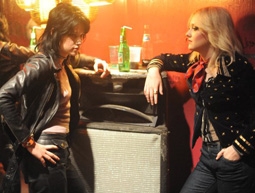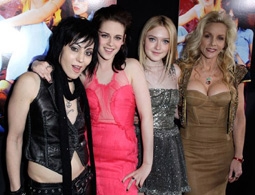




Sex, drugs, and rock n’ roll fill every moment of The Runaways, a film opening March 19th that traces the rise and fall of Joan Jett’s historic all-female rock band. Who needs a well-developed plotline or complex dialogue when an audience can be easily entertained by lesbian eroticism, powerful musical performances, and teenage experimentation? The Runaways, directed by Floria Sigismondi and produced by Joan Jett, documents the difficulties female musicians faced in the 1970’s.

Kristen Stewart and Dakota Fanning star as Joan Jett and Cherie Currie, members of the rock band The Runaways. Both girls come from broken homes and fragmented families. Desperate for attention, they avoid normalcy through drug, sex, and music, and their music innovation makes them stars. “You girls are going to be bigger than the Beatles,” their strange, yet well-connected manager Kim Fowley (played by Michael Shannon) tells them. “There isn’t anything like this on the radio.”

In The Runaways, Kristen Stewart as Joan Jett throws her body into the role, adopting a tomboy stance and manner as she demands the right to be a female rock star. Her manager, however, does not have the same goals, claiming, “This is about women’s libido, not women’s liberation.” Stewart emits the same fierce, dark energy that comes across in her character from the Twilight series. In The Runaways, the energy is appropriately placed, and she fits into the role with ease.

Though Joan Jett’s music instructor tells her that girls don’t play electric guitar, she struts up to record producer Kim Fowley (Michael Shannon) outside of a club. He decides to adopt her as his new project, catapulting himself and The Runaways to music legend status by creating the first female rock group.

Fowley teaches the girls how to growl into the microphone and how to “be men” yet simultaneously use their sexuality to win the respect of audience members and music industry bigwigs. “Rock and roll is for the people in the dark,” Fowley muses. “Sex, violence, and revolt: that’s our product.” Rock stardom seems to come only to those who hate the world and everyone in it.

In The Runaways, Fowley feeds the girls’ anger through insults and demands, telling them, including band members played by Scout Taylor-Compton, Stella Maeve and Alia Shawat, to draw upon every emotional experience to inspire their performances.
As the band hit the road to tour internationally, music becomes life and bandmates become family members, friends and lovers. The movie tracks the bumpy progression of popular songs such as “Cherry Bomb” and all the angst that accompanies its transformation from a simple idea to a work in progress, and finally, to a performance in front of sold out stadiums. Strong, foul language permeates the dialogue of this film, and often is unnecessary in its extremity. The ever-present anger towards men becomes excessive. “Guys don’t like girls who are tough,” Joan Jett’s friend tells her before planting her with a big kiss.
However, no relationship or friendship in The Runaways, whether male or female, remained pure; even their manager, Fowley, steals from the band and uses them to advance his own career. Life is tough, especially for confused, frustrated teenage girls struggling to become respected rock musicians.
The Runaways couldn’t escape the predictable plot line – band quarrels, drug overdoses, and the group’s eventual split. Cliché moments in the story of The Runaways were cushioned by a sexual energy that separated this film from any other I have seen recently. No female friendship remained platonic; every musical performance oozed with desire. Snorting drugs on airplanes, consuming alcohol through a water gun, urinating on enemy’s guitars, and kissing best friends are all just a typical day in the life of a Runaway.
Several scenes in The Runaways left my eyes wide with shock. Audience members hurl garbage and broken glass at the band during one of their first performances. Dakota Fanning weirdly lip synchs David Bowie and stares into the audience like a zombie. One bizarre scene involves Kristen Stewart, a band mate, a shower, a knife, and Farah Fawcett. I won’t divulge any more than that. The Runaways is worth seeing just for the spectacle of these unforgettable moments.
To allow the fifteen-year-old Dakota Fanning to play the role of Currie, the Runaways’ blonde bombshell and inexperienced singer, seemed almost indecent. The camera lingered on her body for long periods of time and she strutted on the stage in scandalous, barely-there outfits.
Describing how the band began was not a priority for this film. Cherie and Jett eye each other longingly in a bar, and Jett returns with her manager to entice Cherie to join their band. The band formation process seemed inconsequential and unrealistic. The Runaways shines in its music performances and visual effects, not in its acting performances. Dakota Fanning’s high pitched, innocent voice betrays her attempts to play a rock star. Her tragic trajectory from misguided teen to shining star to drug addict and band member drop-out was startling and disturbing.
The psychedelic visual effects and slow motion perfectly complimented several of the film’s sexual and musical scenes. In one performance, slow motion and flashing red lights make the audience feel as though they popped a few pills along with the Runaways before the show.
By the end of The Runaways, I had enough of Kristen Stewart parading around in her underwear and I could not bear to witness another drug overdose by Dakota Fanning. I gained a new and great respect for Joan Jett and the Runaways as the first female rock group to push their way to the top of the music charts. The Runaways held my attention throughout the entire film in a strange, yet engrossing way.
The Runaways
Rated R. Runtime 105 min. Theatrical release 3/19/2010.
PR.com Rating: B+
